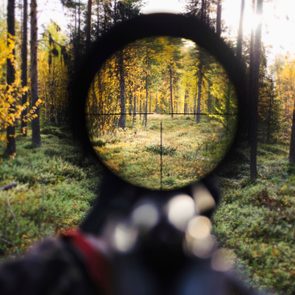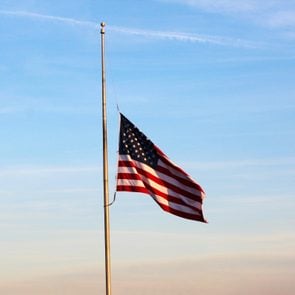Why Better Mental Health Care Won’t Stop Mass Shootings, According to a Psychiatrist
Updated: Mar. 27, 2023

Everyone deserves access to the mental health care they need, but that wouldn't mean the end of gun violence
Ten years ago, I answered a 6:30 a.m. phone call that changed my life. “Lynne,” my supervisor said on the other end of the line, “it’s our guy. He did it. Turn on the news.”
When I switched on my computer, I was met with graphic images of the aftermath of a mass shooting at a movie theater in Aurora, Colorado, and the reporter’s voiceover: “Police have in custody James Holmes, a former student at the University of Colorado.”
I fell back into my chair. As a psychiatrist and the medical director of the student mental health clinic at the University of Colorado, I had seen countless patients over the years, but none stood out like Holmes. And though it was hard for me to wrap my head around this horrific act of gun violence, I wasn’t really shocked: For the few months I had treated Holmes, I had a bad feeling about him that never went away.
In total, Holmes killed 12 people and injured 70. Since then, mass shootings like the one that occurred a decade ago at the Century 16 megaplex in Aurora have continued at an alarming rate—including recent incidents in Uvalde, Texas; Buffalo, New York; and Highland Park, Illinois—with gun violence statistics serving as a constant reminder that the problem only seems to be getting worse.
We’ve seen how other countries respond to mass shootings, but the United States has taken a different approach. Even now, with some red flag laws in place and commonsense gun laws making their way through Congress, many people believe that inadequate mental health care is the reason it’s so hard to stop gun violence in America. But that’s a myth—and one that I’m on a mission to dispel.
What it was like treating a future mass shooter
My sixth and final appointment with Holmes was about six weeks before he opened fire during a midnight showing of The Dark Knight Rises. A few months prior to that, the 24-year-old neuroscience graduate student sought treatment at the university’s mental health clinic, upon the recommendation of one of his professors who had noticed how nervous Holmes was during class presentations.
During his intake evaluation with a social worker on our team, Holmes mentioned that he had thoughts of killing people. Although my colleague said she didn’t think he was dangerous, she wanted to make sure that was the case and referred him to see me.
Holmes was incredibly awkward and constantly looked and acted nervous. In addition to discussing his anxiety, I asked him about his thoughts of killing people, but getting any kind of response out of him was like pulling teeth. When he finally did answer a question, it was typically with vague, one-word answers. No matter how hard I tried to understand where he was coming from, I got nowhere. I prescribed some basic anxiety medication, but that only seemed to help minimally, and though I tried adjusting the doses, it never had much of an effect.
Meanwhile, unbeknownst to me, Holmes had started planning the shooting—casing potential venues, buying guns and ammunition online and in stores (all legally) and going to the shooting range for practice. At several points during our appointments, I asked him if he had any weapons, but his response was always the same: “No.”
Reaching out for additional help
After four sessions, Holmes still wasn’t opening up, so I asked my supervisor—a male psychiatrist—to join me for our next appointment, in case Holmes would be more receptive to questions coming from a man. While he did speak up a bit more, Holmes continued to deny that he had any weapons and refused to expand on his earlier comments about killing people.
My supervisor was also present at what would turn out to be my last session with Holmes, during which he told us that he had failed a major exam and would be dropping out of his program and leaving the university. My colleague and I both offered to continue to see him free of charge—despite the fact that he would no longer be a student. Holmes shrugged and said something to the effect of “Nah, what’s the point?”
Concerned about what could happen once he left the university, I asked Holmes if it would be OK if I gave someone in his family a call. I was hoping they could provide some insight into whether his behavior over the past few months was typical for him or out of the ordinary. Without saying another word, Holmes promptly stood up and left my office.
After this, I decided to call his mother, even if it meant violating federal law. She told me that her son had dealt with “extreme social phobia” and had “trouble adjusting” since he was a small child. I also spoke with several of his professors, all of whom told me that Holmes was brilliant, but had become extremely anxious, and no one wanted to work with him. When I asked the university’s police department about Holmes, an officer told me that his record was clean. Despite the fact that he’d mentioned having homicidal thoughts, I didn’t have any actual evidence that he might pose a threat to himself or others. There was nothing else I could do.
Mental health and gun violence: The numbers don’t add up
When something as horrific as a mass shooting happens, people immediately look for someone—or something—to blame. They want to know how the seemingly unthinkable managed to happen and, more often than not, come to the conclusion that the shooter’s mental health is to blame. In a way, that makes sense, because when you read about the crimes these people commit, it’s natural to conclude that only a person living with serious mental illness is capable of something like that. But the numbers tell a different story.
According to a 2021 analysis from the RAND Corporation’s Gun Policy in America initiative, having a mental illness does not make a person more likely to commit a mass shooting or other acts of firearm violence against other people. It does, however, make a person much more likely than the rest of the population to be the victim of violent crime.

Furthermore, the premise that mass shooters commit these horrific crimes because they live with untreated mental illness—which so many Americans blindly accept as fact—does not hold up when we look at gun violence statistics in the United States versus other industrialized countries. America’s gun deaths occur at a rate 11.4 times higher than other high-income countries, according to a 2019 article published in the journal Preventive Medicine. And yet, the estimated 17% of Americans living with mental illness is on par with figures in other industrialized countries, like France (also 17%), Canada (15%), Germany (15%), Spain (18%) and Australia (19%).
If mental illness really was the singular driving force behind mass shootings, these countries would have gun death figures similar to those in the United States. But the numbers don’t add up. America has approximately 12.2 gun deaths per 100,000 people—substantially more than France (2.83 per 100,000 people), Canada (2.05 per 100,000 people), Germany (0.99 per 100,000 people), Spain (0.62 per 100,000 people) and Australia (1.04 per 100,000 people).
What sets the United States apart from other industrialized countries?
That’s the million-dollar question, of course. Let’s take a look at Canada. Our neighbor to the north has a hunting culture similar to our own, along with that “pioneering spirit” associated with early colonizers who had to fend for themselves and put meat on the table. And yet there are 37.4 civilian-owned guns per 100 people in Canada, while the United States has almost 3.5 times as many (120.5 civilian-owned guns per 100 people). And, yes, you’re reading that correctly: There are more civilian-owned guns than people in the United States.
The difference is accessibility. Canadian gun control laws have been much stricter than those in the United States for decades, making it far more difficult for someone to purchase a firearm legally. And while living with mental illness doesn’t make a person more likely to commit an act of gun violence, there is one thing that all mass shooters do have in common: access to a gun.
What motivates mass shooters to act
If mental illness isn’t to blame for the vast majority of mass shootings, what does tend to lead mass shooters to act? Though their motivations vary and typically involve a combination of factors, here are a few examples identified in research on gun violence, as well as from my work as a practicing psychiatrist:
Extreme anger, entitlement and resentment
While public awareness and understanding of mental health has come a long way in the past few decades, plenty of misconceptions remain. One of the most common is conflating negative emotions and behaviors with clinically diagnosed mental illness. When people claim that perpetrators of mass shootings acted out because they were living with untreated mental illness, far more often than not, they’re referring to individuals who are angry, selfish and entitled and who think the world owes them something. And according to recent research from a team of psychiatrists at Columbia University, these extreme emotions may stem from feelings of exclusion or social rejection.
In other words, people don’t commit mass murder because they’re depressed, anxious or even psychotic. They kill people because they’re angry, frustrated and feel powerless. They opt to pick up a gun and shoot other people because they want to feel more powerful or get back at people who wronged them. But those are emotional reactions—not mental illnesses. Even if we were somehow able to treat every known mental illness, there would still be people who harbor strong feelings of anger and resentment, blame their problems on others and decide to get back at them, or society at large, through acts of gun violence.
Acute stressors
The same study out of Columbia University found that along with general feelings of exclusion, isolation and/or social rejection, acute stressors—like the loss of a job or relationship—can also prompt some mass shooters to act. Sometimes these catastrophic life events are what put someone over the edge. In addition to getting fired or being dumped by a romantic partner, other examples might include being charged with a crime, losing a large sum of money (such as through gambling, bad investments or scams), getting kicked out of school or being publicly humiliated in another capacity.
Of course, the vast majority of people faced with these stressors don’t commit mass shootings. But the research suggests that experiencing severe distress from these life events is a better indicator of whether someone will engage in gun violence than whether they’ve been diagnosed with a mental illness.
A history of violence
The best predictor of future violence is past violence. That’s why it’s not unusual for a mass shooter to have a history of domestic violence, other types of assault and battery, or cruelty to animals. The Columbia study takes a broader approach, identifying a “history of legal problems” as a risk factor for committing mass shootings.
Overall, it’s important to keep in mind that there is no template or formula guaranteed to identify a potential mass shooter before they take action. But when it comes to predictors, the ones we’ve just discussed are more accurate and useful than assumptions and accusations that untreated mental illness is behind any mass shooting that takes place in the United States.
Where do we go from here?
America’s epidemic of gun violence—including mass shootings—cannot and should not be blamed on mental illness. While having more accessible mental health treatments and services would certainly be widely beneficial for the country as a whole, realistically it would probably only make a small dent in the number of mass shootings that take place in the United States. You can’t make people less angry, resentful or entitled through medication, and it’s highly unlikely that individuals who are this emotionally disturbed would agree to go to therapy. Or there could be others like Holmes—people who did get mental health treatment but barely spoke or participated in sessions.
Ultimately, mass shootings will continue to happen as long as acquiring guns in this country remains this easy. And until passing comprehensive gun control legislation is politically possible, red flag laws are our next best tool. Though one is currently in place in Colorado, it didn’t exist when I was treating Holmes. There’s no way of knowing for certain whether it would have made a difference, but having another option for alerting authorities to someone’s potentially dangerous behavior and having firearms removed from their possession temporarily is at least a step in the right direction.
Lynne Fenton, MD, is a psychiatrist based in Colorado. Her book, Aurora: The Psychiatrist Who Treated the Movie Theater Killer Tells Her Story, was released in July 2022, a decade after the mass shooting in Aurora.
Sources:
- National Institute of Mental Health: “Mental Illness”
- Preventive Medicine: “Violent death rates in the US compared to those of the other high-income countries, 2015”
- Our World in Data: “Mental Health”
- World Population Review: “Gun Ownership by Country 2022”
- Public Safety Canada: “Firearms”
- Psychological Medicine: “Psychotic symptoms in mass shootings v. mass murders not involving firearms: findings from the Columbia mass murder database”
- Columbia University Department of Psychiatry: “Is There a Link Between Mental Health and Mass Shootings?”




















